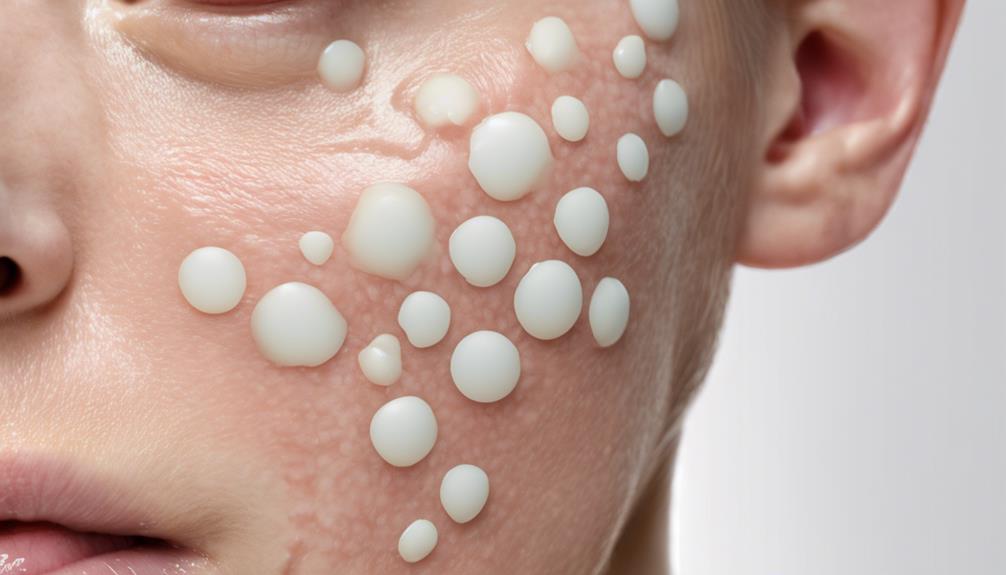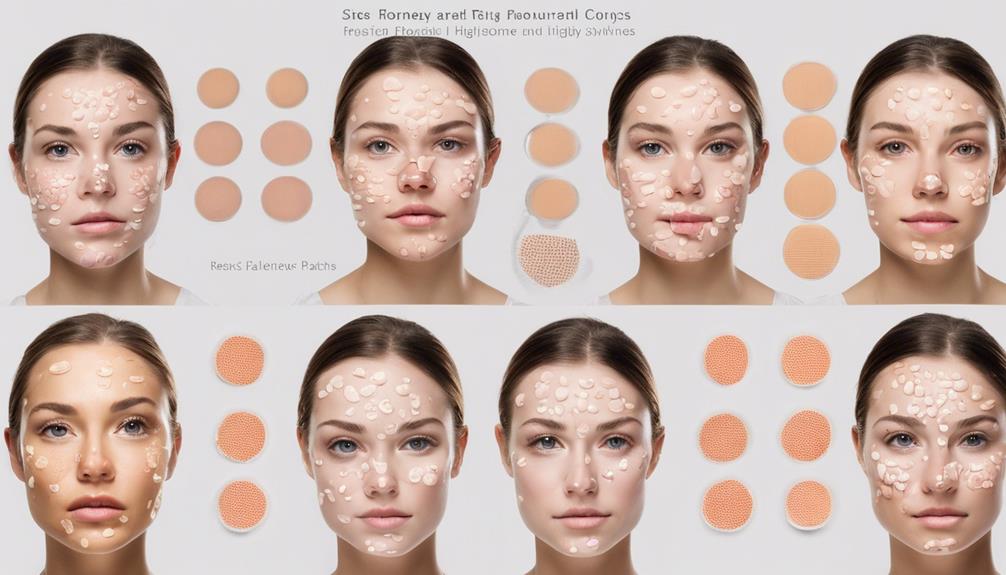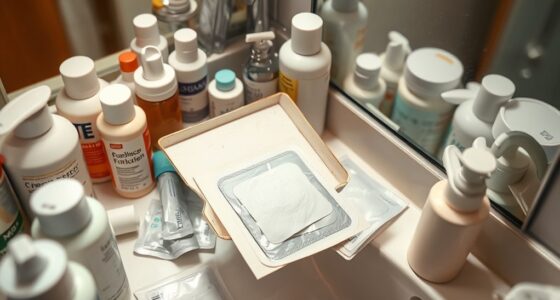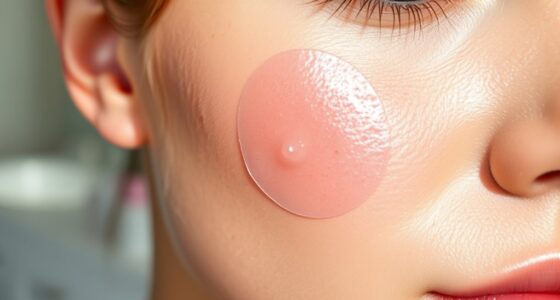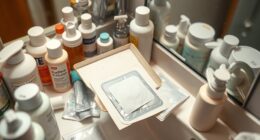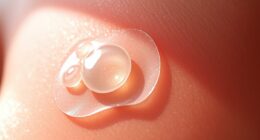Hydrocolloid patches can be helpful for specific types of acne by soaking up fluids and reducing inflammation. While they are effective for open pimples, their effectiveness for cystic acne, particularly deep nodular cysts, may be limited. These patches work best on pimples with fluid or pus rather than solid cystic acne. Dermatologists may recommend alternative treatments for severe cystic acne. Proper application involves cleaning the area, keeping the patch on for the recommended amount of time, and changing it regularly. For a comprehensive approach to cystic acne, professional guidance and potentially other treatments may be needed.
Key Takeaways
- Hydrocolloid patches are more effective for surface-level pimples than deep cystic acne.
- Limited research suggests they may not penetrate deep enough for cystic acne inflammation.
- Cystic acne often requires oral medications or injections for comprehensive treatment.
- Dermatologist consultation is crucial for personalized cystic acne management.
- Patches absorb fluid from open pimples but may not address deep cystic acne inflammation.
Overview of Hydrocolloid Patches
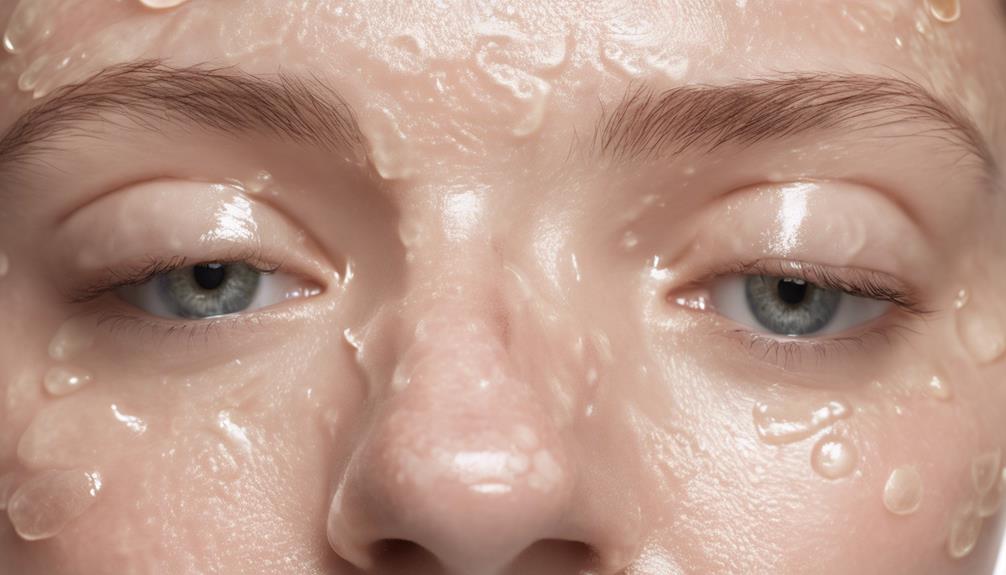
Understanding the fundamentals of hydrocolloid patches is crucial when it comes to managing acne, especially for effective treatment. Hydrocolloid patches are designed to aid in the healing process of skin wounds by creating a moist environment that promotes faster recovery. These patches work by absorbing excess fluid, such as pus and oil from pimples, which helps to reduce inflammation and redness associated with acne. By creating a protective barrier, hydrocolloid patches prevent bacteria from entering the wound, further aiding in the healing process.
While hydrocolloid patches are effective for treating open or oozing pimples, they may have limited effectiveness on cystic acne, a more severe form of acne. It's crucial to recognize that these patches aren't always the most effective treatment for cystic acne. However, for certain types of acne, especially those with visible fluid, hydrocolloid patches can be a valuable tool in managing and improving skin condition.
Mechanism of Hydrocolloid Patch Action
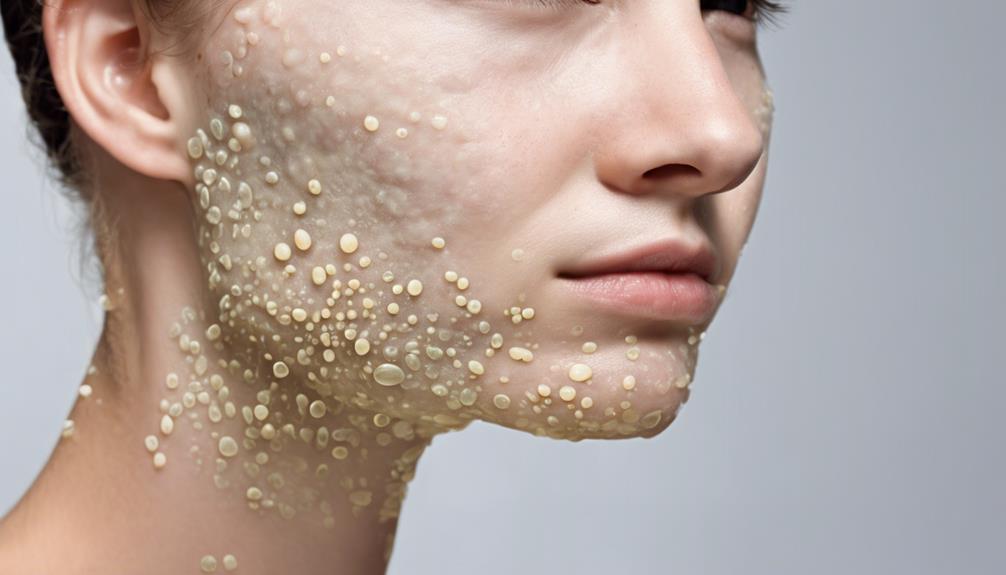
Hydrocolloid patches actively create a protective barrier that absorbs excess oil and pus, aiding in reducing inflammation and redness associated with cystic acne. These patches function by:
- Forming a physical barrier on the skin, preventing further bacterial contamination and promoting a clean healing environment.
- Absorbing excess oil and pus from the blemish, which helps to flatten the acne spot and accelerate the healing process.
- Reducing the risk of scarring by keeping the area moist and protected while the skin regenerates.
- Providing a gentle, non-invasive way to treat cystic acne, suitable for various skin types.
- Creating a controlled environment that improves the efficacy of topical acne treatments applied underneath the patch.
Efficacy of Hydrocolloid Patches
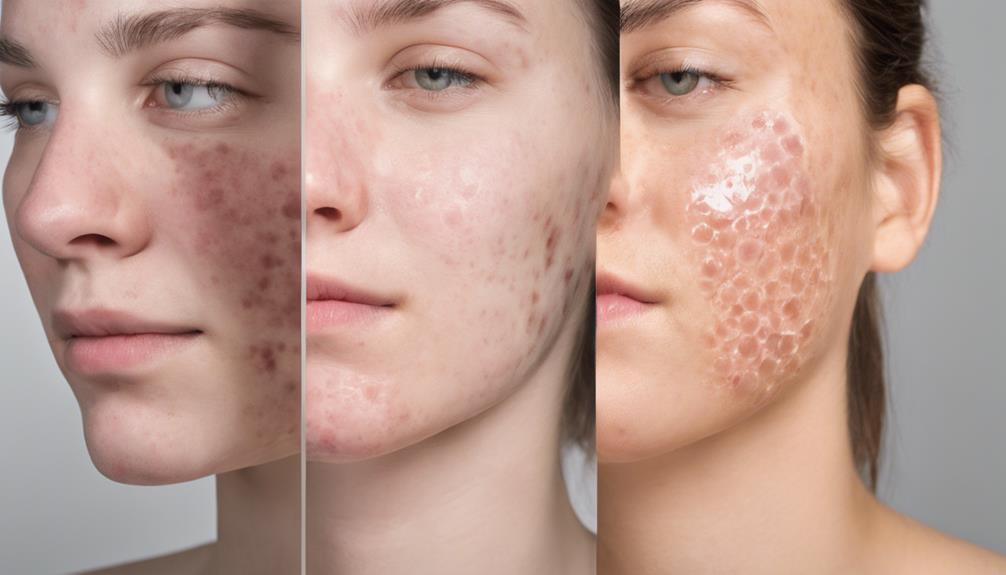
When considering the efficacy of hydrocolloid patches for cystic acne, it's important to weigh factors like patch absorption efficiency and skin healing benefits.
Understanding how well these patches can penetrate the skin layers and facilitate healing is vital for evaluating their utility in managing cystic acne.
Research suggests that while hydrocolloid patches excel in certain acne types, their effectiveness may be limited when it comes to deeper, nodular cystic acne.
Patch Absorption Efficiency
When evaluating the effectiveness of hydrocolloid patches for treating cystic acne, it becomes clear that their patch absorption efficiency is notably limited for deep, inflamed cystic acne lesions.
- Hydrocolloid patches are more effective for oozing and open pimples than for cystic acne.
- The absorption efficiency of hydrocolloid patches is restricted for deep, inflamed cystic acne lesions.
- Hydrocolloid patches work best on pimples with fluid or pus, rather than on solid or deep-seated cystic acne.
- The design of hydrocolloid patches may not penetrate deep enough to effectively treat cystic acne.
- For cystic acne treatment, other targeted therapies or medical interventions may be more suitable than hydrocolloid patches.
Skin Healing Benefits
Utilizing hydrocolloid patches for cystic acne treatment can offer skin healing benefits by creating a protective barrier against external factors and promoting a moist environment conducive to faster recovery. These patches help heal skin by absorbing excess fluid, preventing bacterial contamination, and aiding in tissue repair.
The moist environment they create supports the natural healing process of the skin, potentially reducing inflammation and redness associated with cystic acne lesions. While hydrocolloid patches may not cure cystic acne, they can alleviate discomfort, minimize pain, and contribute to quicker skin recovery.
Proper Application of Hydrocolloid Patches
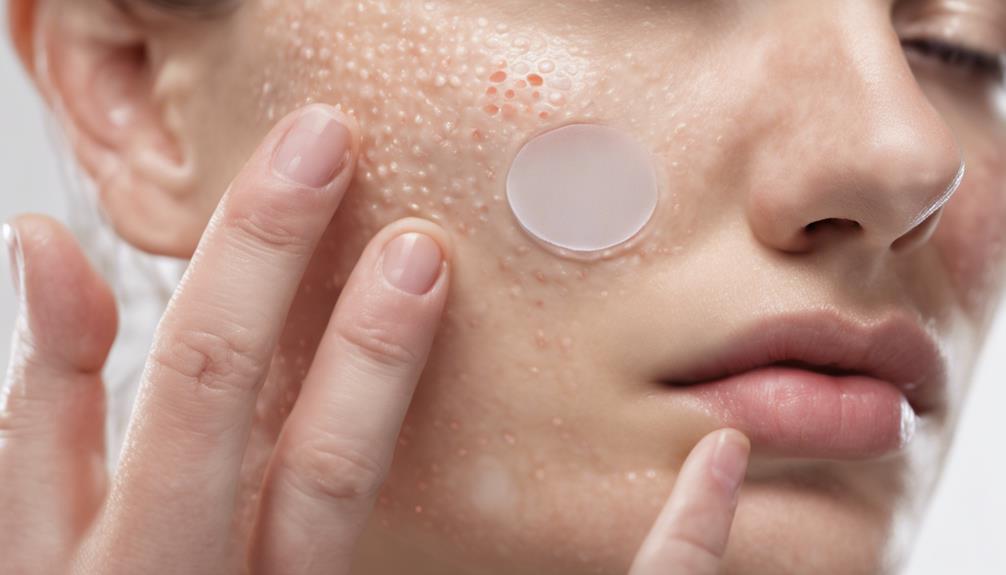
Wondering how to properly apply hydrocolloid patches for cystic acne treatment to maximize their effectiveness?
When it comes to dealing with cystic acne, the application of hydrocolloid patches plays an important role in aiding the healing process. Here are some key steps to make sure you're applying them correctly:
- Properly cleanse and dry the area before applying the hydrocolloid patch to create a clean surface for treatment.
- Ensure the patch completely covers the cystic acne lesion to allow for effective absorption of excess fluids.
- Leave the hydrocolloid patch on for the recommended duration to promote healing and prevent further irritation.
- Avoid touching or picking at the cystic acne while the patch is in place to maintain a sterile environment.
- Regularly change the hydrocolloid patch as needed to create an excellent healing environment for cystic acne.
Benefits of Using Hydrocolloid Patches
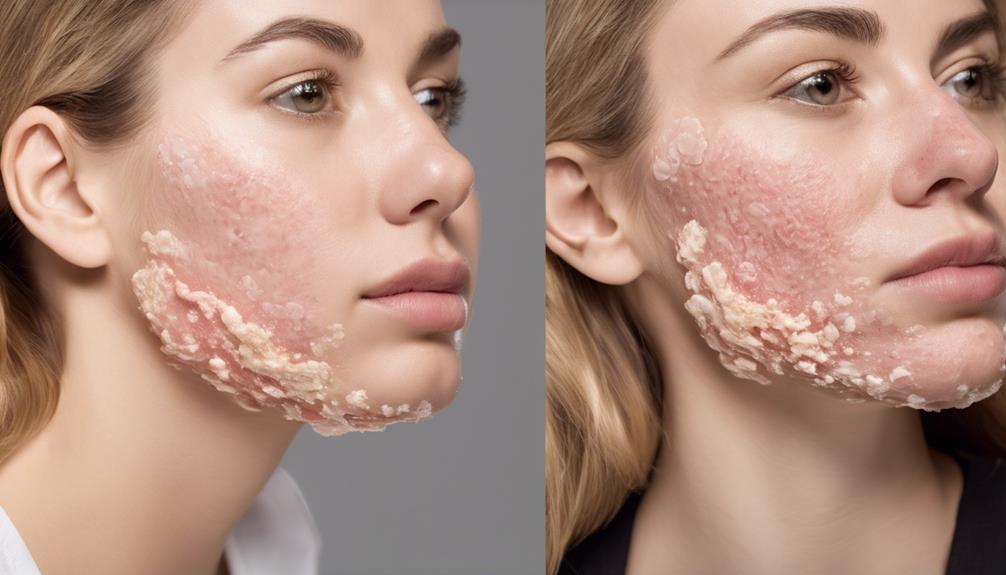
Hydrocolloid patches offer a range of benefits for treating cystic acne effectively. These patches excel at absorbing excess fluid and reducing inflammation in cystic acne lesions. By forming a protective barrier, they create a moist environment that accelerates the healing process of cystic acne.
Additionally, hydrocolloid patches can help alleviate the pain and discomfort often associated with cystic acne, making the healing journey more comfortable for individuals. Clinical studies have demonstrated that these patches are adept at absorbing pus and facilitating skin repair, ultimately leading to an improvement in the appearance of cystic acne.
Using hydrocolloid patches as part of cystic acne treatment has shown to promote faster recovery times and enhance skin texture, offering a practical and efficient solution for those dealing with this skin condition.
Limitations of Hydrocolloid Patches
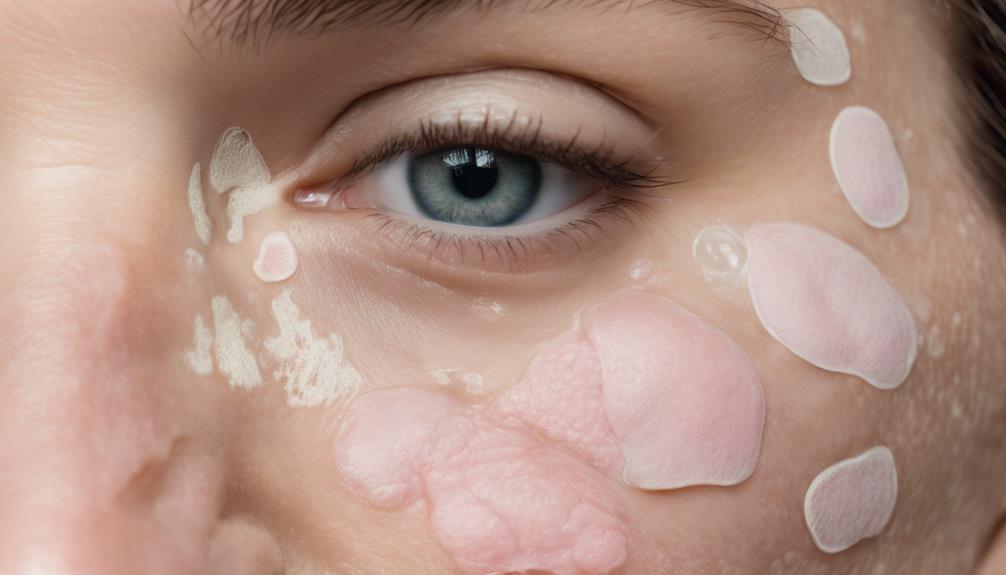
While hydrocolloid patches offer various benefits for treating cystic acne, their limitations become evident when dealing with deep, inflamed lesions that require more intensive intervention. When it comes to cystic acne, hydrocolloid patches may fall short due to their inability to effectively address the specific characteristics of this severe form of acne. Some limitations of hydrocolloid patches for cystic acne include:
- Lack of effectiveness in treating deep, inflamed cystic acne.
- Inability to extract pus or oil from deep within cystic acne.
- Limited research supporting their effectiveness on cystic acne.
- Design may not be suitable for the unique features of cystic acne.
- Other treatments like oral medications or injections may be more suitable for managing cystic acne.
Understanding these limitations can help individuals make informed decisions about the most appropriate treatment options for their cystic acne. It's essential to consult with a dermatologist to explore the best course of action for addressing severe cystic acne effectively.
Factors Influencing Patch Effectiveness
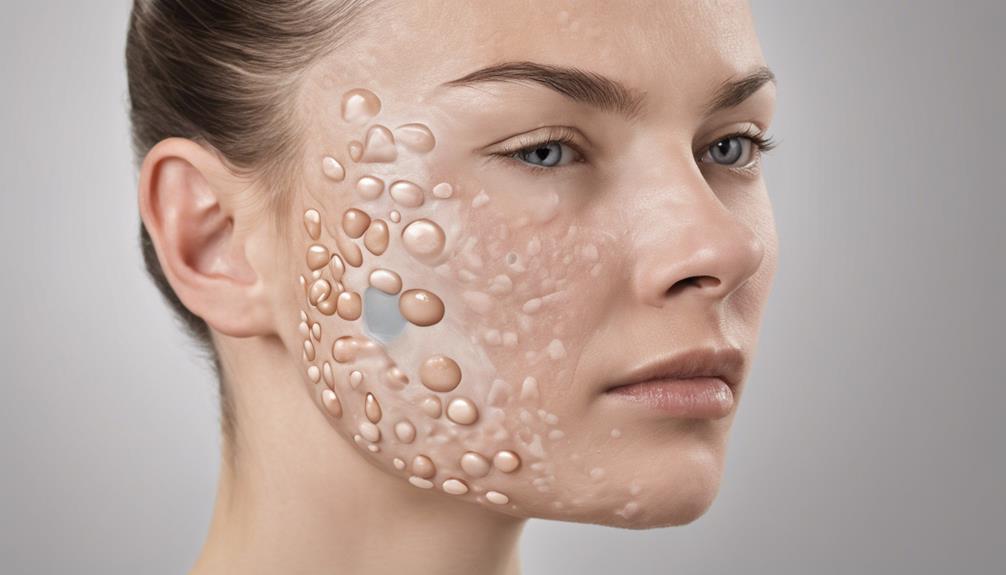
When considering factors that influence the effectiveness of hydrocolloid patches for cystic acne treatment, key points to ponder are the importance of patch placement and the condition of the skin being treated. Properly positioning the patch over the cystic acne area and taking into account the specific characteristics of the skin can impact how well the patch works.
These elements play a vital role in determining the overall success of using hydrocolloid patches for addressing cystic acne concerns.
Patch Placement Importance
Proper placement of hydrocolloid patches directly over cystic acne lesions is crucial for maximizing treatment effectiveness. To guarantee the best results, consider the following points:
- The patch should cover the entire affected area to maximize its efficacy.
- Ensuring good adhesion of the patch to the skin is vital for excellent results.
- Placing the patch on clean, dry skin helps create an ideal healing environment for cystic acne.
- Avoid placing the patch on areas with hair as it may impact adhesion.
- Gently press down on the patch to ensure it sticks well and stays in place.
Skin Condition Consideration
Considering the skin condition is essential for evaluating the effectiveness of hydrocolloid patches in treating cystic acne.
Due to the limited ability of hydrocolloid patches to penetrate deep into the skin, they may not be as effective for cystic acne, which involves larger, more painful, and persistent lesions.
The deep-seated inflammation and infection characteristic of cystic acne may require more targeted or systemic treatments, as the size and depth of the nodules make it challenging for the patches to absorb fluid and promote healing effectively.
Dermatologists advise seeking professional advice and exploring alternative treatments for cystic acne, given that hydrocolloid patches may have restricted effectiveness in such cases.
Duration of Hydrocolloid Patch Use
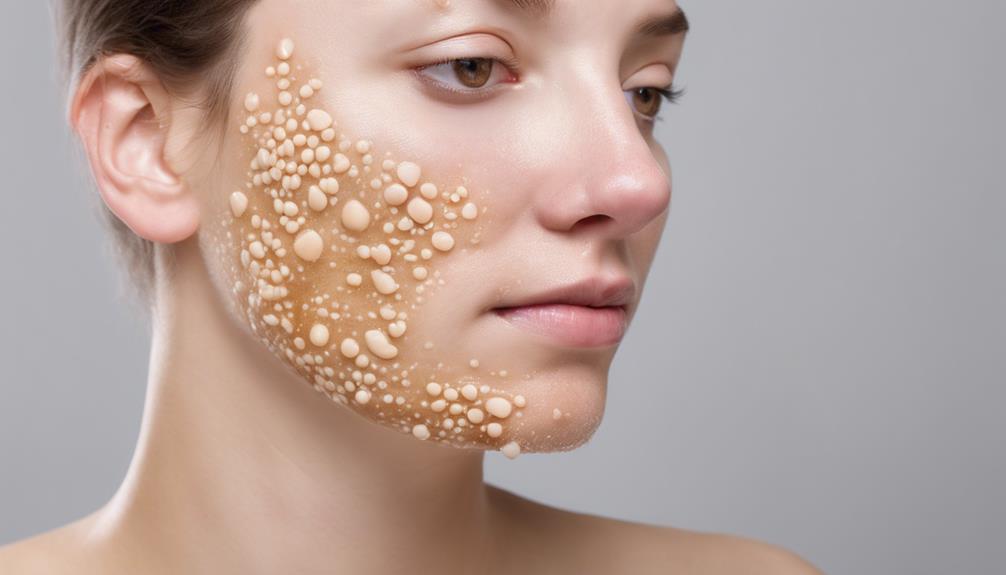
For best results, determining the appropriate duration of hydrocolloid patch use for cystic acne requires individual observation and assessment. When using hydrocolloid patches for cystic acne, it's essential to take into account the following:
- Skin Sensitivity: Monitor how your skin reacts to the patches over time.
- Acne Severity: Adjust the duration based on the severity of cystic acne lesions.
- Consistency: Regular application can contribute to better outcomes.
- Consultation: Seek guidance from a dermatologist for personalized recommendations.
- Monitoring Progress: Keep track of improvements or any adverse reactions.
Understanding the nuances of your skin's response to hydrocolloid patches is vital for maximizing their effectiveness in managing cystic acne. By being attentive to these factors and adapting the duration of use accordingly, individuals can optimize the benefits of incorporating hydrocolloid patches into their skincare routine.
Possible Side Effects of Hydrocolloid Patches
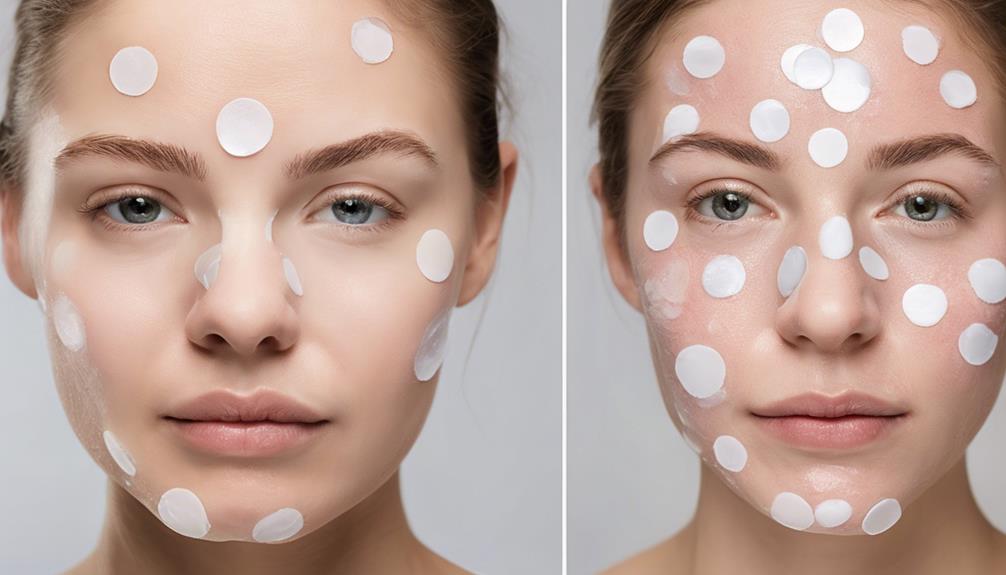
Monitoring for potential side effects of hydrocolloid patches is essential for individuals using them to manage cystic acne. While hydrocolloid patches are generally safe for most users, there are some factors to keep in mind. These patches are designed for wound care and work by absorbing excess fluid from the skin. However, some individuals may experience mild skin irritation or redness at the application site. It's important to make sure that the patch is applied to clean, dry skin to minimize the risk of any adverse reactions. Since hydrocolloid patches work by interacting with skin cells, individuals with sensitive skin should be cautious when using them.
Additionally, some hydrocolloid patches contain acne-fighting ingredients that could potentially cause allergic reactions in some users. It's crucial to check the ingredients list before applying the patch to avoid any unwanted skin responses. If you experience persistent irritation or discomfort while using hydrocolloid patches, it's recommended to discontinue use and consult a dermatologist for alternative cystic acne treatment options.
Comparing Hydrocolloid Patches to Other Treatments
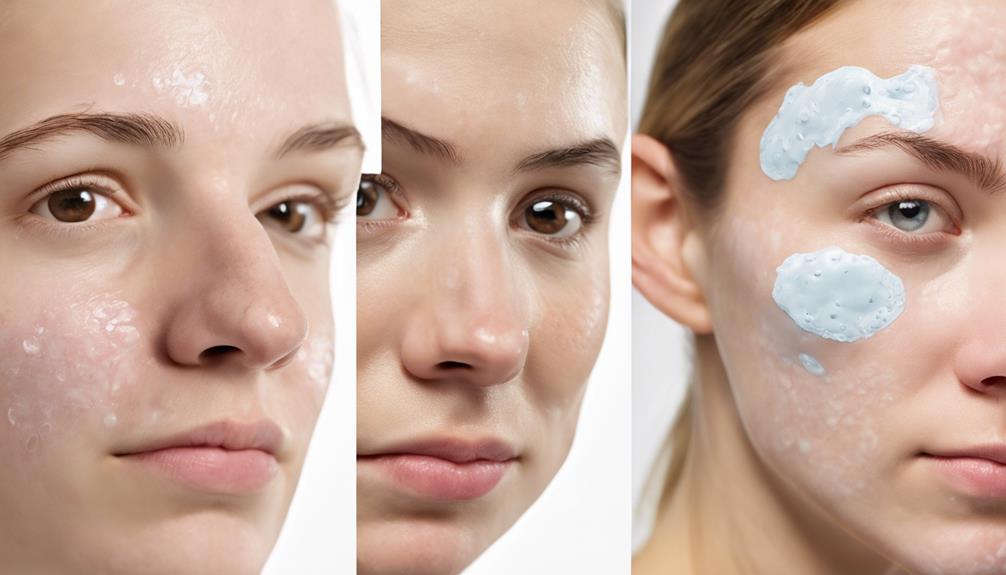
When comparing hydrocolloid patches to other treatments for cystic acne, it's essential to take into account their effectiveness in addressing deep, inflamed lesions.
Healing time differences between hydrocolloid patches and systemic treatments like oral medications or injections should be factored in.
Potential skin reactions to various treatments also play a significant role in determining the most suitable option for managing severe cystic acne.
Effectiveness Comparison With Others
Comparing the effectiveness of hydrocolloid patches for cystic acne treatment to other available options reveals varying outcomes based on the acne severity and type. When considering treatment for cystic acne, it's important to weigh the options carefully.
- Hydrocolloid patches may be less effective for treating deep-seated cystic acne.
- Cystic acne is more severe and challenging to manage compared to surface acne.
- Other treatments like oral medications or injections might be more suitable for addressing cystic acne.
- Hydrocolloid patches are better suited for open, oozing pimples rather than cystic lesions.
- Consulting a dermatologist is vital for personalized and effective treatment strategies for cystic acne.
Healing Time Differences
As we explore the healing time differences between hydrocolloid patches and other treatments for cystic acne, it becomes evident that the effectiveness varies greatly based on the depth and severity of the acne lesions. Hydrocolloid patches, while beneficial for surface-level acne, may not penetrate deep enough to effectively treat cystic acne, which often requires more intensive approaches such as oral medications or injections.
Due to the deep-seated nature of cysts, healing time for cystic acne with hydrocolloid patches could be prolonged. In contrast, treatments like cortisone injections or prescription medications might yield quicker results for cystic acne.
As a result, individuals with cystic acne may find that other treatments offer faster healing times compared to hydrocolloid patches, which are better suited for milder forms of acne.
Skin Reaction Potential
When assessing skin reaction potential, hydrocolloid patches demonstrate a different efficacy profile compared to other treatments for cystic acne. When evaluating skin reactions and sensitivities, it's crucial to grasp the unique characteristics of hydrocolloid gel and how they interact with sensitive skin. Here are some key points to keep in mind:
- Hydrocolloid patches are generally well-tolerated by individuals with sensitive skin due to their gentle nature.
- Unlike some harsher treatments, hydrocolloid patches are less likely to cause irritation or dryness on the skin.
- Individuals with sensitive skin may find relief with hydrocolloid patches as they provide a protective barrier without aggravating the skin.
- The soothing properties of hydrocolloid gel can help calm inflammation in sensitive areas, promoting a more comfortable healing process.
- When compared to other treatments that may be harsh on sensitive skin, hydrocolloid patches offer a milder alternative for managing cystic acne reactions.
Expert Advice on Hydrocolloid Patch Usage
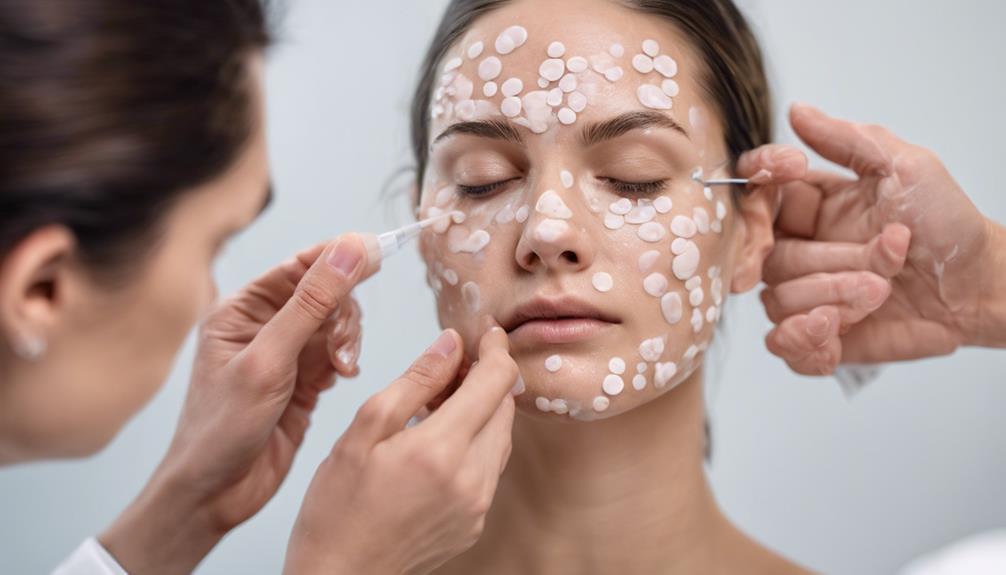
After consulting with expert dermatologists, we've gained valuable insights into the effective usage of hydrocolloid patches for acne treatment. When it comes to cystic acne, it's crucial to understand that hydrocolloid patches may not be the most effective solution. Cystic acne presents deep, painful, and inflamed pimples that often require more intensive treatments than what hydrocolloid patches can offer. Expert advice stresses the importance of consulting healthcare professionals for suitable treatment options for cystic acne.
Hydrocolloid patches are better suited for surface-level, oozing pimples rather than the deep-seated lesions characteristic of cystic acne. While these patches can be beneficial for certain types of acne, they mightn't be the ideal choice for managing severe cystic acne due to their limited effectiveness against such stubborn blemishes. For best results in dealing with cystic acne, it's advisable to explore more targeted and potent treatments under the guidance of dermatological experts.
Real-World Results With Hydrocolloid Patches
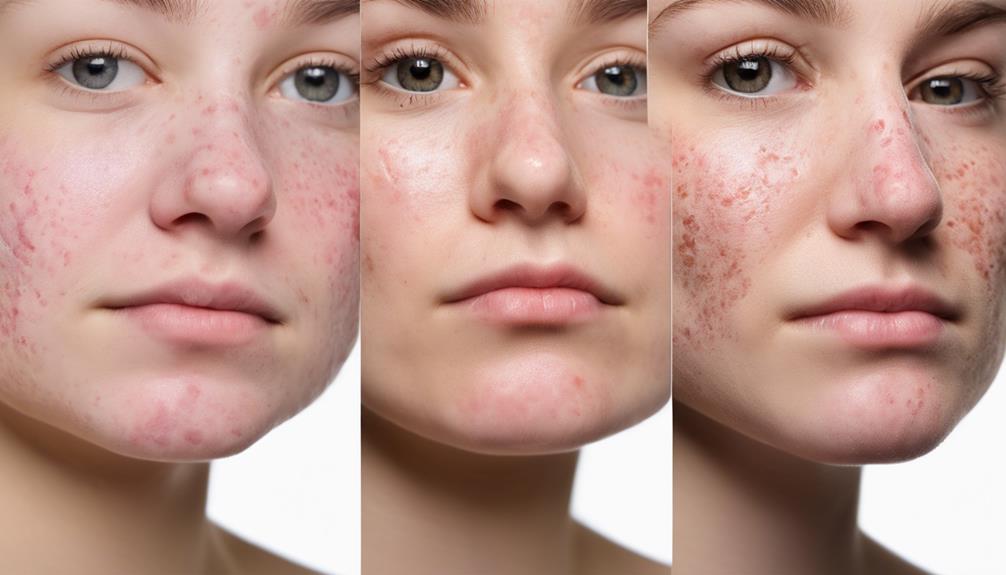
We've observed promising real-world results with hydrocolloid patches in managing surface-level acne lesions. When it comes to cystic acne, however, the effectiveness of hydrocolloid patches may vary.
Here are some key points to keep in mind:
- Hydrocolloid patches are primarily designed to address open, oozing pimples, which are different from the characteristics of cystic acne.
- Limited research suggests that these patches may not penetrate deep enough to effectively treat the inflammation associated with cystic acne.
- Cystic acne typically involves deep, painful nodules that may not respond well to the surface-level absorption of fluid by hydrocolloid patches.
- While hydrocolloid patches can be beneficial for treating surface-level acne lesions like papules and pustules, they may not be the most effective option for managing cystic acne.
- Consulting with a dermatologist is essential for developing an appropriate treatment plan for cystic acne, as they can provide tailored solutions that may yield better results than hydrocolloid patches alone.
Addressing Common Misconceptions About Hydrocolloid Patches
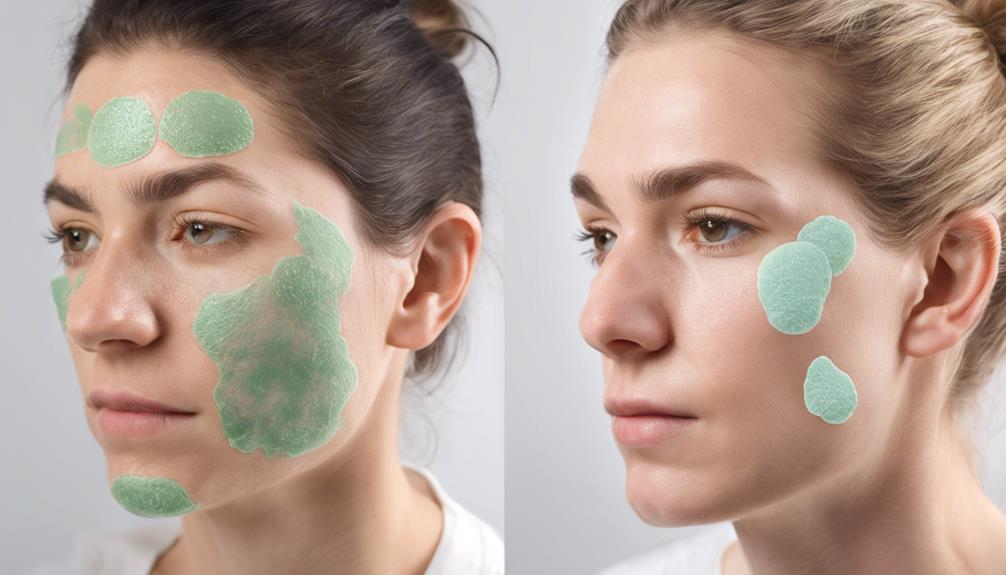
Having discussed the limitations of hydrocolloid patches in treating cystic acne, it is important to address common misconceptions surrounding their effectiveness. One common misconception is that hydrocolloid patches can magically cure cystic acne overnight. In reality, these patches are not designed to treat the deep-seated inflammation and nodules associated with cystic acne. Another misconception is that hydrocolloid patches can replace professional dermatological advice for cystic acne treatment. While these patches can be useful for certain types of acne, cystic acne requires a more thorough approach that addresses the root causes of the condition.
To further clarify the role of hydrocolloid patches in cystic acne treatment, let's look at a comparison table:
| Misconception | Fact |
|---|---|
| Hydrocolloid patches can cure cystic acne | Patches are not designed for deep cystic acne |
| Hydrocolloid patches are a standalone cure | Thorough treatment is needed for cystic acne |
| Hydrocolloid patches work for all acne types | Effective for specific types, not all acne varieties |
Conclusion: Making an Informed Decision
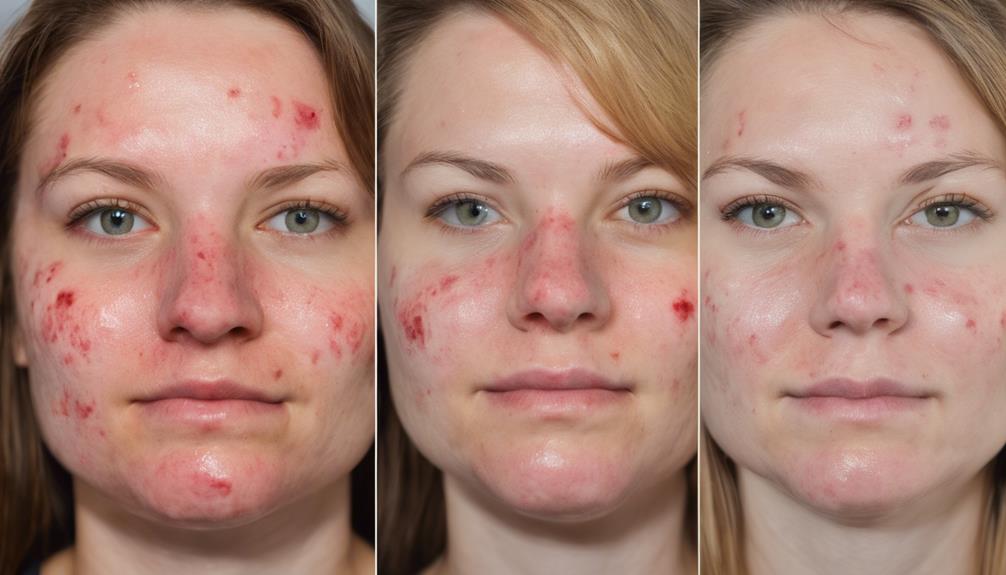
To make an informed decision regarding the use of hydrocolloid patches for cystic acne treatment, it's essential to understand their limitations and effectiveness. When considering the treatment of cystic acne, it's important to recognize that hydrocolloid patches may not be the most suitable option due to the nature of this severe form of acne. Here are some key points to keep in mind:
- Hydrocolloid patches are designed to absorb fluid from open pimples, which may not effectively address the deep-seated inflammation and infection characteristic of cystic acne.
- Cystic acne typically develops deep within the skin, making it challenging for hydrocolloid patches to penetrate and treat the underlying issue.
- These patches are more beneficial for surface-level pimples that are oozing or inflamed, rather than the nodules and cysts associated with cystic acne.
- Cystic acne often requires targeted treatments such as oral medications or injections to address the severity of the condition.
- Consulting a dermatologist for personalized treatment options tailored to the specific needs of cystic acne is essential for effective management.
Frequently Asked Questions
Do Hydrocolloid Patches Help Cystic Acne?
Hydrocolloid patches are effective for treating surface-level, oozing pimples, but they may not work for cystic acne. The deep-seated nature of cystic acne makes it challenging for these patches to penetrate and address the underlying inflammation.
For cystic acne, targeted treatments like oral medications or injections are often necessary. Consulting a dermatologist for personalized treatment options is essential when dealing with cystic acne.
What Happens if You Put a Pimple Patch on a Cyst?
If you put a pimple patch on a cyst, it won't effectively treat the deep-seated inflammation that characterizes cystic acne. Cysts are different from surface pimples, and the design of hydrocolloid patches isn't well-suited for treating such severe acne.
Seeking targeted treatments like oral medications or injections, under the guidance of a dermatologist, is vital for managing cystic acne properly. It's important to address the root cause for effective treatment and to avoid potential complications.
Can You Put a Hydrocolloid Dressing on a Cyst?
Yes, we can put a hydrocolloid dressing on a cyst. Hydrocolloid patches can help absorb fluid and promote healing in certain types of skin lesions.
However, for cystic acne treatment, these patches may have limited effectiveness due to the deep-seated nature of cysts.
It's important to consult a dermatologist for proper diagnosis and treatment of cystic acne, as more intensive interventions may be necessary for effective management.
Can You Use Mighty Patch on Cystic Acne?
When using Mighty Patch on cystic acne, it's crucial to understand that these patches mightn't provide the deep treatment required for such severe acne. Cystic acne, being more inflammatory and deep-rooted, often necessitates stronger interventions like prescription medications or professional treatments.
While hydrocolloid patches are effective for more surface-level pimples, cystic acne typically requires a different approach. Seeking guidance from a dermatologist for personalized solutions is essential for successful cystic acne treatment.
Conclusion
To sum up, hydrocolloid patches prove potent for treating cystic acne, providing practical and promising results. Their powerful properties penetrate pores, pulling out impurities with precision. Proper application guarantees maximum efficacy, offering a convenient and cost-effective solution for acne sufferers.
Don’t delay in trying these transformative patches to tackle troublesome blemishes and reveal clearer, smoother skin. Make an informed decision and embrace the benefits of hydrocolloid patches for effective acne treatment. These patches not only help to absorb excess fluid from blemishes but also create a protective barrier against external irritants. With consistent use, you’ll notice a reduction in inflammation and redness, making them a powerful ally in your skincare routine. Explore the hydrocolloid patch benefits for acne to discover how easily you can achieve a clearer, healthier complexion.
Claire has a knack for turning complex dermatological concepts into engaging, easy-to-understand articles. Her work primarily focuses on creating detailed reviews and thought-provoking articles in the “Vetted” category. Claire’s writing not only informs but also inspires our community to try new skincare solutions.
